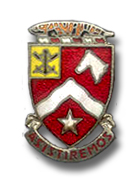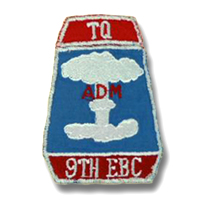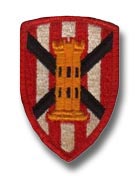| If you do
NOT see the Table of Contents frame to the left of this page, then
Click here to open 'USArmyGermany' frameset |
||||
|
9th
Engineer Battalion |
||||
|
|
||||
|
||||
|
|
||||
| Battalion History | ||||
| 1957 - 1962 | ||||
 9th Engineer Battalion DUI
9th Engineer Battalion DUI |
||||
| (Source: A Short History of the 9th Engineer Battalion, Aschaffenburg, Germany, 1962) | ||||
|
In the mid-1950's,
the US Army initiated a system of unit overseas rotation known as
"Gyroscope." Under the "Gyroscope" concept,
an overseas unit would trade places with a like unit from the United
States. On these moves, only individual equipment and weapons would
be transported, the majority of the organic equipment remaining
in place to be assumed by the new unit. SERVICE
IN GERMANY The
Main is a picturesque river rising near the Czech border in the
mountains of northeast Bavaria. Following a serpentine route in
a general westerly direction it flows through the vineyards of Franconia,
finally joining the Rhine River near the cities of Mainz and Wiesbaden.
With the aid of an extensive series of dams and locks, the river
is navigable to the city of Bamberg, where flat-bottomed barges
and boats may enter the Regnitz Canal. Moving downstream from Bamberg,
the Main flows through the industrial city of Schweinfurt, then
veers southward to pass through Kitzingen and Ochsenfurt. It then
swings toward the north through the Lower Franconian capital of
Wuerzburg until it is forced southward again by the Spessart Mountains.
Skirting the eastern, southern, and western edges of the wooded
Spessarts, it follows a beautiful valley leading into Aschaffenburg
and then enters a broad plain as it passes through Hanau, bisects
the modern city of Frankfurt, and joins the Rhine for its journey
to the North Sea. |
||||
| If you have more
information on the history or organization of the 9th Engr Bn, please
contact me |
||||
|
|
||||
| 1959 | ||||
| (Source: Welcome Pamphlet, 9th Engr Bn, 1959) | ||||
|
||||
| "Home of the
9th" Smith Barracks is home. Here you eat, sleep, work, pull guard duty, and best of all - get paid. The local citizens know it as La Garde Kaserne, named for a large forest near Paris which served as a famous World War I battlefield. It was completed in 1937 and was the headquarters of the 106th Infantry Regiment of the German Army until 1945. For three years the kaserne lay unoccupied; when restored it housed Headquarters and the 3rd Battalion of the 18th US Infantry Regiment. The kaserne was re-designated Smith Barracks in honor of Colonel George A. Smith, the Commanding Officer of the 18th who was killed in action 1 March 1945. He had been awarded the Silver Star for gallantry in action in the vicinity of St. Laurent-sur-Mer, Normandy, on D-Day 1944. These units remained until 1955 when they were replaced by the 87th Infantry Regiment, whose tenure ended in July of 1957. The 9th (Engr Bn) took over in November of that year and has kept house up to the present, just recently expanding to take over part of Jaeger Kaserne. This was the result of the addition of Co D to the battalion, new facilities being needed to house the increased number of personnel. Co A moved into a section of the Education Building in Jaeger Kaserne, thus leaving adequate room for the new company. Besides well-equipped day rooms, this kaserne contains a large gymnasium, the home of "Colts", and an eight-lane-bowling alley. The EES also maintains a pick-up point for laundry, shoe and watch repair etc . . . . |
||||
|
|
||||
| (Source: Email from Ronald Carnaghi, C Company, 9th Cbt Engr Bn) | ||||
| I was in the 9th from November 1959 to September 1961. Was in both Wintershields, was in cleanup of Wintersheild 2 at Grafenwohr when the wall was put up in Berlin. When I first got there I was the Comany clerk because I previously had typing experience. I worked for Sgt. Major Harold H. Hood. I can't remember our CO's name. I had four MOS's so in March of 1960 I transferred back to being a Heavy Equipment Operator. I operated a Bulldozer and drove a tractor trailer lowboy. In the summer of 1960 we were on bridge training for crossing the Rhine River when the Hellicopter carying the cable across the river had to drop it because of the wind. The bridge work was completed successful on that day. Some of the men in the equipment crew were SP-5 Hobbs , SP-4 Ebert, SP-4 Larry Darlington, PFC Al Nixon, PFC Pennington, and myself, SP-5 Ron Carnaghi. Some of the Platoon Sgts. were Hicks, Musselwhite, Randolph, Mathews. In the fall of 1960 the Company received a Michigan rubber tire end loader and I became the operator of it. In the spring the Company returned to Grafenwoehr for the restoration of the farmland and roads. We were out doing the work when the Berlin Crisis happened. We were immediately put on alert and ready to move out. The barracks we lived in had outside walls that were 3 ft thick and housed C & D company's. They had two floors and also a game room and a basement with tailor and barber shop. I have lost track of names of the Battalion Commander. Also, in our Company our Lieutenants were 1st Lt Pouscheck, 2nd Lt Loschabo. It was a great experience of my life, do not regret it. |
||||
| 1960 | ||||
| (Source: Email from Walter King) | ||||
| Service in 9th Combat Engineer Battallion, A Company, Headquarters Squad 1960 to 1963 | ||||
|
||||
| 1964 | ||||
| (Source: Aschaffenburg Reunion Page) | ||||
| Click here to read a write up by Colonel Paul S. Denison, CO of the 9th ECB from 1964-1966. Well written, interesting reading! Discusses the challenges of battalion command. (File is in PDF format.) | ||||
 9th Engr Bn photo, 1963 |
||||
| (Source: Email from William R. Petrie) | ||||
|
Looking at your website today and noticed that the Organizational Chart is missing my unit:
9th Engr BN (CBT)
Our primary responsibility was about 100 miles of the River Main, Frankfurt to Wurzburg, as I recall.
I served with A Company 9th Engr BN (CBT) from March 1965 - May 1967 and wore the VII Corps patch the entire time.
I have setup a unit page on Military.com http://unitpages.military.com/unitpages/unit.do?id=801950 whick includes info from the BN Commander, a story posted by my Plt Leader, LT Farmer and a Unit history. (A Company 9th Engr BN) |
||||
| (Source: Email from Robert Farmer, 9th Engr Bn, 1965-66) | ||||
| I was just on
your website and saw your article about the 9th Engineer Bn history.
I was in the 9th Engr Bn from April 1965 until about May-June, 1966. Harold D. Morgan was my second company commander and was my best man at my wedding in 1966. The picture he sent was the bridge I remember helping to build. I was a 2nd Lt and platoon commander of the 1st & 3rd platoons of A Company, 9th Eng Bn. Later, after my wedding in 1966, I was assigned to our sister battalion, the 82nd Engr Bn, in Bamberg, Germany, and was there from 1966 till 1967. I was the S-4 Supply Officer and special assistant to the CO. Co A (9th Engr Bn) built two bridges over the Rhine: the first in 1965 and second in 1966. One was at Speyer, and the other near Heidelberg, Germany. We also built bailey bridges and timber trestle bridges as part of our training, like all Engr Bn's. My wife was from Brand bei Marktredwitz, north of Grafenwoehr. Brand was a base for a 2nd Armored Cavalry Regiment, which patrolled the Border between West Germany, East Germany, and Checloslavakia. My first platoon command was to renovate the roads leading up to the camp and making a helicopter landing pad. We also did some other work inside of the old camp. The camp is now used by the town of Brand/Marktredwitz. Co A was assigned to the Main River bridges from Aschaffenburg to Wurzburg, and the canal locks, and all of the roads around. Co A used to build a lot of soccer fields in the Aschaffenburg area. Every year we would go to Grafenwoehr for a month of construction projects, like tank firing pads. Also, once a year we went to Hohenfelds for combat training, and live firing. There we had our live explosives training and orientation and familiarization with the Army's latest weapons. We also had special maneuvers with the Bundeswehr and the other Combat outfits of 7th Corps, Seventh Army Europe. I have seen where the 7th Corps was assigned to the Gulf War in 1980-81, and my outfit, the 9th and 82nd were probably involved. Robert Farmer |
||||
|
|
||||
| (Source: Email from Harold D. Morgan, A Co, 9th Engr Bn, 1966-68) | ||||
|
||||
| ADM Platoon | ||||
 ADM Pltn, 9th
Engr Bn CBT Pocket Patch
ADM Pltn, 9th
Engr Bn CBT Pocket Patch |
||||
| ADM Platoon | ||||
| (Source: Email from Eugene D. Arial, ADM Pltn, 1971-1973) | ||||
| I was stationed in A-burg with the 9th Engr. Bn. ADM Platoon from 1971-1973, I was a Team Chief for most of my there I did act as the PSG for some of the time. We had a real good bunch of soldiers and we not only worked hard, but we played hard also. There was another saying for the TQ part of the patch, I'm sure you can figure it out. The bad part about wearing that patch on our uniforms was it made us easy to spot when we were some place we shouldn't be. If any of you old 12E's would like to hook up with some other 12E's go to www.567thadm.org -- we have had 2 reunions so far and are planning on having one every 2 years. Next one should be in 2008 in the Pacific Northwest. I can remember some names from the past and would like to hear from you, please excuse the spelling: George M. Kivii Jr., Tom Kapski, John Rybecky 1lt, Barry Kent PSG, Earl Kasco, Brad P. Mantha, Dan Blocher (run through the woods naked), Walter Erb Christsen, Blotzie (document clerk), Smalley, Howard, Robert Brown, Palmer, Fransworth, & my driver Cinnonmy (comic book collector). Just to name a few I can remember right now. Eugene D, Arial (Bucket Ass) |
||||
| (Source: Email from John H. Maher, ADM Pltn, 1974-1975) You have a question mark (Webmaster: now removed. Thanks, John!) after your picture of the 9th Engineer ADM Platoon patch. If you are questioning, that is exactly what it is. It was a two part pocket patch, the TQ on top be awarded only after someone was Technically Qualified . . . . . we also called it Tequila Qualified after a long standing tradition. I was with the 9th ADM Platoon in 1974 and was part of the group that moved the platoon to the consolidated 275th Engineer Company in Ludwigsburg in early 1975. The 9th ADM Platoon became the 1st Platoon of the 275th. We were the first group to move from A-burg to Ludwigsburg. I can't seem to remember which platoons came next. I do remember, although I lived "off post", that the third floor at Coffey wasn't completely done when the 9th platoon got there. We took one end of the 2nd floor and the next group in the other. There was about a month when we were there alone. We also had to take turns going back to A-Burg to cover NRAS for at least a month, maybe more. I was the NCOIC of the Coffey Barracks theatre for awhile, which was fun. We had a medical unit, don't remember their number, on Coffey with us. I spent my last 8 months as a ADM site inspector, which means I had to drive all over Germany counting our weapons and sending reports back to Washington. I was not a long time ADM person, I came from the 101st Airborne (Ranger) Co, Vietnam and Ft. Campbell. Somehow they thought a 12D40P was right for a ADM assignment. I got 2 weeks of ADM training before going to Germany. I felt like a fish out of water, the ADM Platoons were much more laid back than what I was use to. The ADM guys had a reputation of Ain't Doing Much. But had the ballon gone up we pretty much knew if the Russians didn't get us our own weapon probably would. In just about every scenario we would be heading East while everyone else was heading West. |
||||
|
|
||||
| Related Links: 9th Engineer Battalion - official web site of the unit that still serves in Germany; check out Page 2 in the Glance at Our History section - some Cold War photos of the unit |
||||








